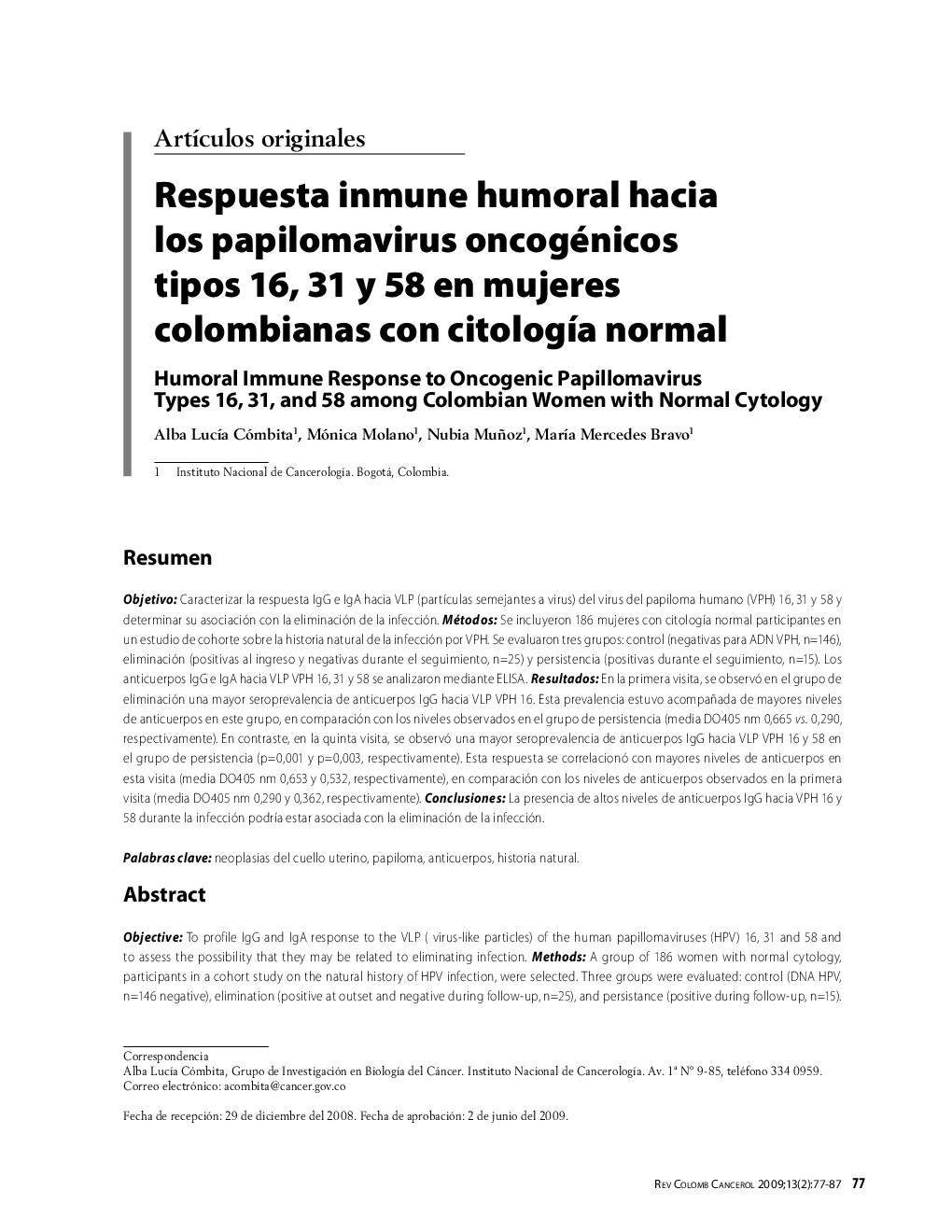| Article ID | Journal | Published Year | Pages | File Type |
|---|---|---|---|---|
| 3997372 | Revista Colombiana de Cancerología | 2009 | 11 Pages |
ResumenObjetivoCaracterizar la respuesta IgG e IgA hacia VLP (partÃculas semejantes a virus) del virus del papiloma humano (VPH) 16, 31 y 58 y determinar su asociación con la eliminación de la infección.MétodosSe incluyeron 186 mujeres con citologÃa normal participantes en un estudio de cohorte sobre la historia natural de la infección por VPH. Se evaluaron tres grupos: control (negativas para ADN VPH, n = 146), eliminación (positivas al ingreso y negativas durante el seguimiento, n = 25) y persistencia (positivas durante el seguimiento, n = 15). Los anticuerpos IgG e IgA hacia VLP VPH 16, 31 y 58 se analizaron mediante ELISA.ResultadosEn la primera visita, se observó en el grupo de eliminación una mayor seroprevalencia de anticuerpos IgG hacia VLP VPH 16. Esta prevalencia estuvo acompañada de mayores niveles de anticuerpos en este grupo, en comparación con los niveles observados en el grupo de persistencia (media DO405 nm 0,665 vs. 0,290, respectivamente). En contraste, en la quinta visita, se observó una mayor seroprevalencia de anticuerpos IgG hacia VLP VPH 16 y 58 en el grupo de persistencia (p = 0,001 y p = 0,003, respectivamente). Esta respuesta se correlacionó con mayores niveles de anticuerpos en esta visita (media DO405 nm 0,653 y 0,532, respectivamente), en comparación con los niveles de anticuerpos observados en la primera visita (media DO405 nm 0,290 y 0,362, respectivamente).ConclusionesLa presencia de altos niveles de anticuerpos IgG hacia VPH 16 y 58 durante la infección podrÃa estar asociada con la eliminación de la infección.
ObjectiveTo profile IgG and IgA response to the VLP (virus-like particles) of the human papillomaviruses (HPV) 16, 31 and 58 and to assess the possibility that they may be related to eliminating infection.MethodsA group of 186 women with normal cytology, participants in a cohort study on the natural history of HPV infection, were selected. Three groups were evaluated: control (DNA HPV, n = 146 negative), elimination (positive at outset and negative during follow-up, n = 25), and persistance (positive during follow-up, n = 15). The IgG and IgA antibodies against HPV-VLP 16, 31, and 58 were submitted to ELISA analysis.ResultsDuring the initial visit greater IgG antibody seroprevalence against HPV16-VLP was observed among the elimination group. This prevalence was combined with greater antibody levels in this group in comparison with the levels found among members of the persistence (mean DO405 nm 0.665 vs. 0.290, respectively). In contrast, during the fifth visit, there was greater IgG antibody seroprevalence against HPV-PLV 16 and 58 among the persistance group (p = 0.001 and p = 0.003, respectively). This response correlated with greater anitbody levels on this visit (mean DO 405 nm 0.653 and 0.532, respectively) in comparison with the antibody levels observed on the first visit (mean DO 405 nm 0.290 and 0.362, respectively).ConclusionHigh levels of IgG antibodies working against HPV 16 and 58 during infection phase may be associated with elimination of infection.
